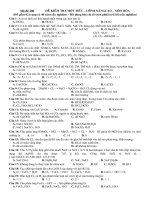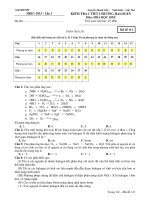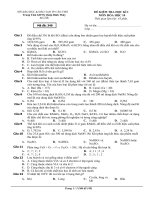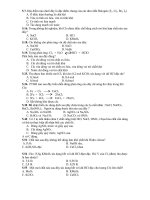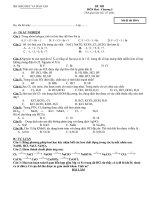1 lithium halogen exchange
Bạn đang xem bản rút gọn của tài liệu. Xem và tải ngay bản đầy đủ của tài liệu tại đây (576.71 KB, 3 trang )
Myers
Lithium-Halogen Exchange
RLi + R'X
Chem 115
H
RX + R'Li
Br
Lithium-halogen exchange reactions are kinetically controlled. The position of the equilibrium
varies with the stabilities of the carbanion intermediates involved (sp >> sp2 >> sp3)
H
1.1 eq n-BuLi
H
OEt
Et2O, !80 °C
Li
H
OEt
Lau, K. S.; Schlosser, M. J. Org. Chem. 1978, 43, 1595.
n-PrLi
+ PhI
n-PrI + PhLi
1:10,000
1. 2 eq t-BuLi
2. n-C8H17Br
Br
H3C
Li
I
LiI
I
Keq << 1
I
THF-ethyl ether-pentane
!120 °C
CH3
H3C
77%
Li
I
Neumann, H.; Seebach, D. Tetrahedron Lett. 1976, 17, 4839.
In the above example, internal trapping of the newly formed alkyllithium reagent by alkylation
drives an otherwise unfavorable exchange reaction.
Alkyliodides are more reactive than the corresponding bromides. Alkylchlorides are
essentially inert.
Lithium-halogen exchange of vinyl halides is stereospecific, proceeding with retention of
configuration.
I
1. 2.1 eq t-BuLi
2. !78 " 23 " !78 °C
3. benzaldehyde
OH
n-pentane-ethyl ether (3:2)
2 t-BuLi
+
RI
t-BuI
+
t-BuLi
RLi
isobutene + isobutane + LiI
Lithium-halogen exchange reactions using t-BuLi typically employ two or more equivalents of
t-BuLi. The first equivalent is used for the exchange and the second equivalent reacts with
the t-BuI produced, to form isobutene, isobutane, and lithium iodide.
Bailey, W. F.; Punzalan, E. R. J. Org. Chem. 1990, 55, 5404.
Aliphatic alkyllithium reagents are normally prepared from the corresponding primary
iodides at low temperature in a pentane-ether solvent system.
Dionicio Siegel
1
Myers
Lithium-Halogen Exchange
Chem 115
Lithium-halogen exchange is extremely fast. In some instances, the rate of
lithium-halogen exchange can exceed the rate of proton transfer.
Mechanism of Lithium-Halogen Exchange:
2 eq t-BuLi
Review:
2 CH3OH
I
Bu
H
pentane-ether
!78 °C
5 min.
Bailey, W.F.; Patricia, J. J. J. Organomet. Chem. 1988, 352, 1.
93%
Li+
BuI
I
Li
I
Reich, H. J.; Phillips, N. H.; Reich, I. L. J. Am. Chem. Soc. 1985, 107, 4101.
Added phenyl iodide slows the reaction of butyl iodide with phenyllithium, providing
evidence for the intermediacy of a less reactive "ate-complex."
Bailey, W. F.; Patricia, J. J.; Nurmi, T. T.; Wang, W. Tetrahedron Lett. 1986, 27, 1861.
Lithium-halogen exchange is typically more rapid than addition reactions that might
compete.
OCH3
H3CO
H3CO
I
H3CO
2 eq t-BuLi
O
OCH3
N
CH3
H3CO
THF, !78 °C
O
OCH3
64%
F
F
F
F
F
F
I
F
F
Aidhen, I. S.; Ahuja, J. R. Tetrahedron Lett. 1992, 33, 5431.
F
Li+
2 TMEDA
F
O
O
Farnham, W. B.; Calabrese, J. C. J. Am. Chem. Soc. 1986, 108, 2449.
Br O
O
HN
n-BuLi
Ph
THF, !100 °C
~100%
O
O
O
NHR
H
Paleo, M. R.; Castedo, L.; Dominguez, D. J. Org. Chem. 1993, 58, 2763.
An X-ray crystal structure of lithium bis(pentafluorophenyl) iodinate complexed
with TMEDA has been obtained, providing support for the intermediacy of ate
complexes during lithium-halogen exchange.
The 9-phenylfluorenyl protecting group is particularly useful in minimizing the rate of
epimerization of adjacent labile centers, such as the "-amino ketone above.
Lubell, W. D.; Rapoport, H. J. Am. Chem. Soc. 1987, 109, 236.
Dionicio Siegel
2
Myers
Lithium-Halogen Exchange
Chem 115
Examples of Lithium-Halogen Exchange in Synthesis:
N
Br
H
2.6 eq t-BuLi
Et2O, !78 °C
CH3
Li
H
CH3
I
OH
O
O
H
Br
O
N
1. 1.05 eq LiHMDS Cl
2. 1.05 eq t-BuLi
3. AcOH
OH
TBSO
OTBS
2.
H
Cl
I
1. MgBr2•OEt2
H3C CH3
THF, !96 °C
OTBS
Myers, A. G.; Goldberg, S. D. Angew. Chem., Int. Ed. Engl. 2000, 39, 2732.
H3CO
I
H3C
CH3
CH3
1. 2.2 eq t-BuLi
H
TBDMSO
2. H3CO
O
OCH3
2.2 eq n-BuLi
SO2Ph
OH
H
H
H3C
H
OH
CH3
CH3
OCH3
H
94%
OCH3
TBDMSO
CHO
O OH
THF, !78 °C
HO
OH
TBSO
79%
Cyclopropyl bromides, unlike normal aliphatic bromides, can be reliably converted to the
corresponding organolithium reagents. Pretreatment of the cyclopropyl anion with
magnesium bromide ethyl etherate in the example above prevents a second, unwanted
lithium-halogen exchange reaction from occuring between the cyclopropyllithium reagent
and the aryl iodide.
Br
O
60%
Overman, L. E.; Ricca, D. J.; Tran, V. D. J. Am. Chem. Soc. 1997, 119, 12031.
CH3O
O
O
CH3
CHO
Br
H3C CH3
H3C
O OH
N
hexane-ethyl ether, !78 °C
SO2Ph
60%
Morphine
Bogenstatter, M.; Limberg, A.; Overman, L. E.; Tomasi, A. L. J. Am. Chem. Soc.
1999, 121, 12206.
Toth, J. E.; Fuchs, P. L. J. Org. Chem. 1986, 52, 473.
Consider the relative rates of the processes that must occur in the above transformation.
Dionicio Siegel
3
